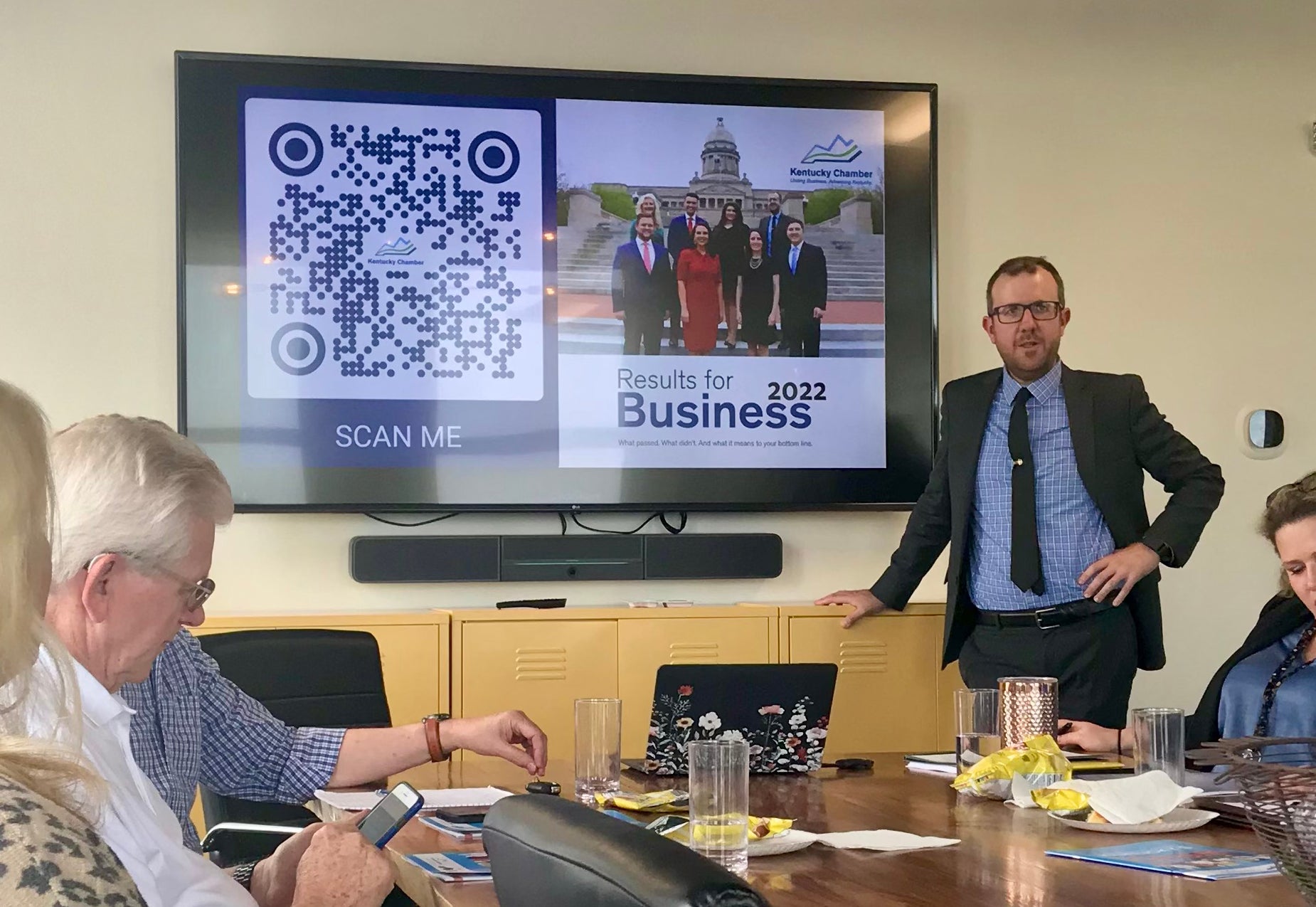New laws to help combat low workforce participation
Published 4:12 pm Thursday, July 28, 2022

- Charles Aull (right) presents the new bills. Scan the QR code to see the Chamber’s full report on legislation.
FIONA MORGAN
Businesses are still struggling to hire workers, and low workforce participation is one thing to blame. However, several laws were recently passed to help the issue.
After this year’s legislative session ended in April, the Kentucky State Chamber shared with Boyle County several laws they worked on that will hopefully increase workforce participation in the state.
Amy Cloud from the Kentucky Chamber of Commerce Executives, and Charles Aull, senior policy analyst, made a presentation in May about the changes.
The Kentucky Chamber released a study in 2021 about Kentucky’s workforce crisis, which took data from over 20 years. When it came out, Kentucky ranked 48th out of the 50 states for workforce participation at 56.3%. North Dakota had the highest participation at 68.8%.
The study defines the workforce as “individuals with jobs plus unemployed individuals who are actively looking for work.” This does not include institutionalized or retired people, or those not old enough to work.
Kentucky’s participation rate is highest in counties with larger cities, and lowest in rural areas, especially Eastern Kentucky. Out of each county’s participation rate, Boyle County is in the second lowest percentile range of 51.3%-56.5%.
Jeff Jewel, executive director of the Danville Boyle County Chamber of Commerce, said, “Workforce development has moved way up as one of our largest issues, everything from childcare, in our case affordable housing, open jobs…”
While Kentucky has had among the lowest participation rates in the U.S. for 20 years, the Covid-19 pandemic amplified the problem. In January 2000, 63.5% of Kentucky adults participated in the workforce. Right before the pandemic, it was 59.2%. In January 2021, it was 56.3%.
Aull explained some of the reasons for low participation are the retirement boom; the skills gap, where more jobs are requiring training, credentialing and degrees that many people looking for work don’t have; the opioid epidemic, which may be responsible for a 1.3-3.1% loss in Kentucky’s workforce; a lack of access to childcare; less people between the ages of 16 to 19 looking for work; and government assistance programs.
Among other major laws that passed, House Bill (HB) 8 will gradually phase out Kentucky’s income tax, which will hopefully draw more people to the state and ultimately the workforce, Aull said.
Many people who struggle with substance abuse, have been incarcerated, or have felonies on their record, often have trouble finding jobs.
To help address the substance use disorder epidemic and hopefully put more recovered people in the workforce, Senate Bill 90 will give eligible individuals the option to receive treatment for a behavioral health disorder instead of incarceration. Successful completion of the program will result in dismissal of the criminal charges. 10 counties have been chosen for the pilot program.
One major barrier to employment, especially in Boyle County, is lack of access to childcare. For many parents, it’s more financially feasible to stay home to care for their kids than to work and spend much of their income on childcare.
HB 499 encourages employers to offer a benefit of childcare for employees, and the state will match that benefit dollar for dollar. This bill is unique to Kentucky.
“We’re really excited about this bill,” Aull said. “A lot of states are watching us on this.”
Jewel said the Danville chamber helped in pushing this bill to get passed, and Aull thanked them for the help.
“Having this robust engagement of all business communities, all our chambers throughout the state, that’s what got that bill across the finish line,” Aull said.
Another barrier involving childcare is that childcare is almost nonexistent for second or third shift workers, which Aull said they hope to help address in the future.
Unemployed Kentucky workers spend on average 18.5 weeks on unemployment insurance, which is much longer than the national average of about 14 weeks. HB 4 reforms Kentucky’s unemployment insurance system to support re-employment and workforce development. HB 144 freezes the unemployment insurance tax at before-pandemic rates, saving employers about $75 per employee in tax increases.
Other bills that will help Kentucky’s workforce are HB 708 (addressing benefits cliffs), HB 9 (helping early literacy), HB 10 (addresses nursing shortage), HB 1/HB 66 (requires all school districts to offer full day kindergarten), and others.
Representative for Boyle and Casey Counties Daniel Elliott voted yes on all of these bills.
Aull said there are about two open jobs available for every unemployed worker in the state. Boyle County has well over 1,000 open jobs, but less than 500 people are classified as unemployed.
To conclude, Aull expressed that local engagement is critical in getting legislation passed. He encouraged people to get involved and reach out to their representatives.






